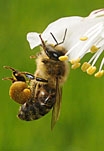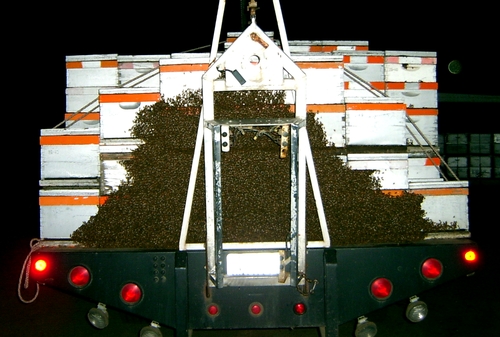
When Extension apiculturist Eric Mussen of the UC Davis Department of Entomology asked California beekeepers for photos of their bee trucks moving out at night to the almond orchards, his call did not go unanswered.
Bob Miller of Miller's Honeybees in Watsonville provided a series of photos.
But let's let him tell the story:
"These photos were taken February 2005. They (bees) had been doing very well and it was a warm evening. We had loaded these colonies near Monterey Bay, and were moving them to Braden Ranch almonds near Snelling.
"This load contained about 135 colonies, and had been given additional supers for honey production about 10 days prior and had pretty much filled them. This is usually not a normal happening at this time of the year. The bees, being warm and on a honey flow, needed to have some breathing room, so out they came. We unloaded them that evening after a three-hour trip. They had not cooled down at all."
Amazing photos. We're glad Bob Miller picked up his camera before heading out; his photos help tell the bee-almond pollination story.
This year's California almond crop is valued at $3.2 billion. NASS (National Agricultural Statistics Service, U. S. Department of Agriculture) forecasts 1.65 billion pounds this year, up 8.5 percent above last year's revised production of 1.41 billion.
However, this may be overstated by 50 million pounds, according to industry consensus.
Mark Jansen, president and CEO of Blue Diamond Growers, writes in the current edition of Almond Facts, that a predominantly wet harvest could "reduce the saleable product by another 20 to 50 million pounds, bringing the likely crop size to between 1.55 and 1.6 million pounds."
And, he writes, "With a consumption growth rate of 8 percent, our industry will need a 2011 crop of more than 1.75 billion pounds to sustain its current growth. As most regions in the world consume more almonds, and with developing nations desiring more protein in their diet plants, almonds are a perfect fit."
California currently has 750,000 acres of almonds in production, with each acre requiring two bee colonies. That's 1.2 million colonies needed to pollinate the almonds, according to honey bee guru Eric Mussen. Since California doesn't have that many colonies--the number is around 500,000--the remainder must come from beekeepers outside the state.
Early varieties of almonds are already blooming, but generally, Feb. 14--Valentine's Day--launches the pollination season for the commercial growers.
At the Harry H. Laidlaw Jr. Honey Bee Research Facility at UC Davis, my favorite almond tree--yes, everybody ought to have a favorite almond tree--is just about to burst into bloom.
The Laidlaw bees and other pollinators are currently foraging in the cape mallow, bush germander, roses and seaside daisies in the Haagen-Dazs Honey Bee Haven.
But they're checking out those almonds.
As are we all.
Attached Images:

Almond Blossoms

Bee Truck

135 Colonies

Bee Cluster